Approximate prediction intervals in the original units when fitting models using data transformations
Abstract
In this paper, we consider prediction interval estimation in the original units of observation after fitting a linear model to an appropriately transformed response variable. We assume that the residuals obtained from fitting the linear model in the transformed space are iid zero-mean normal random variables, at least approximately. We discuss the bias in the retransformed mean and derive a reduced-bias estimator for the kth moment of the original response, given settings of the design variables. This is then used to compute reduced-bias estimates for the mean and variance of the untransformed response at various locations in design space. We then exploit a well-known probability inequality, along with our proposed moment estimator, to construct an approximate 100(1−α)% prediction interval on the original response, given settings of the design factors. We used Monte Carlo simulation to evaluate the performance of the proposed prediction interval estimator relative to 2 commonly used alternatives. Our results suggest the proposed method is often the better alternative when the sample size is small and/or when the underlying model is misspecified. We illustrate the application of our new method by applying it to a real experimental data set obtained from the literature, where machine tool life was studied as a function of various machining parameters.




